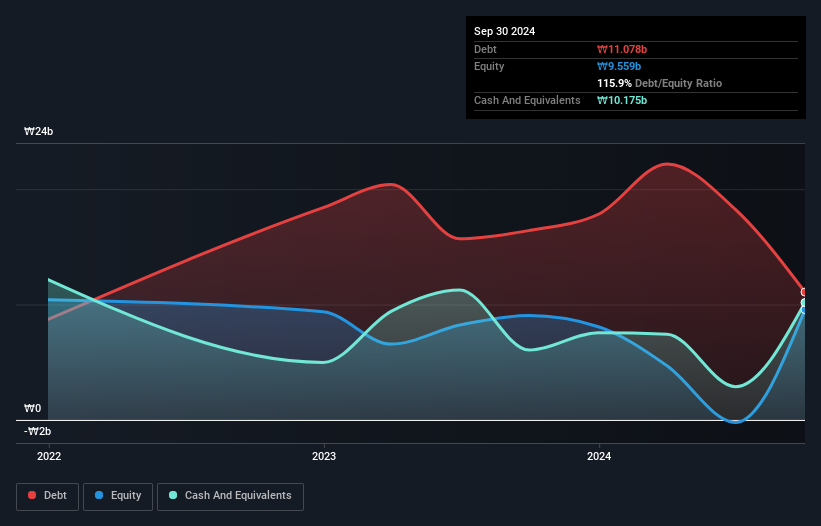- South Korea
- /
- Medical Equipment
- /
- KOSDAQ:A405000
Would Plasmapp (KOSDAQ:405000) Be Better Off With Less Debt?
Legendary fund manager Li Lu (who Charlie Munger backed) once said, 'The biggest investment risk is not the volatility of prices, but whether you will suffer a permanent loss of capital.' So it seems the smart money knows that debt - which is usually involved in bankruptcies - is a very important factor, when you assess how risky a company is. As with many other companies Plasmapp Co., Ltd. (KOSDAQ:405000) makes use of debt. But should shareholders be worried about its use of debt?
Why Does Debt Bring Risk?
Debt assists a business until the business has trouble paying it off, either with new capital or with free cash flow. If things get really bad, the lenders can take control of the business. However, a more common (but still painful) scenario is that it has to raise new equity capital at a low price, thus permanently diluting shareholders. Having said that, the most common situation is where a company manages its debt reasonably well - and to its own advantage. When we examine debt levels, we first consider both cash and debt levels, together.
Check out our latest analysis for Plasmapp
How Much Debt Does Plasmapp Carry?
As you can see below, Plasmapp had ₩11.1b of debt at September 2024, down from ₩16.4b a year prior. On the flip side, it has ₩10.2b in cash leading to net debt of about ₩902.7m.

How Healthy Is Plasmapp's Balance Sheet?
The latest balance sheet data shows that Plasmapp had liabilities of ₩20.2b due within a year, and liabilities of ₩2.49b falling due after that. On the other hand, it had cash of ₩10.2b and ₩7.45b worth of receivables due within a year. So it has liabilities totalling ₩5.05b more than its cash and near-term receivables, combined.
Since publicly traded Plasmapp shares are worth a total of ₩37.0b, it seems unlikely that this level of liabilities would be a major threat. But there are sufficient liabilities that we would certainly recommend shareholders continue to monitor the balance sheet, going forward. There's no doubt that we learn most about debt from the balance sheet. But you can't view debt in total isolation; since Plasmapp will need earnings to service that debt. So when considering debt, it's definitely worth looking at the earnings trend. Click here for an interactive snapshot.
In the last year Plasmapp had a loss before interest and tax, and actually shrunk its revenue by 8.0%, to ₩12b. That's not what we would hope to see.
Caveat Emptor
Over the last twelve months Plasmapp produced an earnings before interest and tax (EBIT) loss. Its EBIT loss was a whopping ₩17b. Considering that alongside the liabilities mentioned above does not give us much confidence that company should be using so much debt. Quite frankly we think the balance sheet is far from match-fit, although it could be improved with time. Another cause for caution is that is bled ₩14b in negative free cash flow over the last twelve months. So in short it's a really risky stock. When analysing debt levels, the balance sheet is the obvious place to start. However, not all investment risk resides within the balance sheet - far from it. For example Plasmapp has 4 warning signs (and 2 which are significant) we think you should know about.
At the end of the day, it's often better to focus on companies that are free from net debt. You can access our special list of such companies (all with a track record of profit growth). It's free.
New: Manage All Your Stock Portfolios in One Place
We've created the ultimate portfolio companion for stock investors, and it's free.
• Connect an unlimited number of Portfolios and see your total in one currency
• Be alerted to new Warning Signs or Risks via email or mobile
• Track the Fair Value of your stocks
Have feedback on this article? Concerned about the content? Get in touch with us directly. Alternatively, email editorial-team (at) simplywallst.com.
This article by Simply Wall St is general in nature. We provide commentary based on historical data and analyst forecasts only using an unbiased methodology and our articles are not intended to be financial advice. It does not constitute a recommendation to buy or sell any stock, and does not take account of your objectives, or your financial situation. We aim to bring you long-term focused analysis driven by fundamental data. Note that our analysis may not factor in the latest price-sensitive company announcements or qualitative material. Simply Wall St has no position in any stocks mentioned.
About KOSDAQ:A405000
Plasmapp
Develops, manufactures, and sells plasma sterilizers for medical tools.
Adequate balance sheet with slight risk.
Market Insights
Community Narratives




